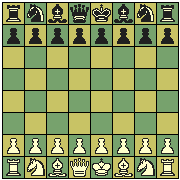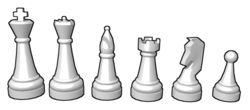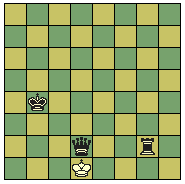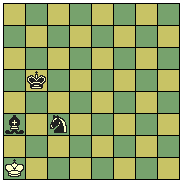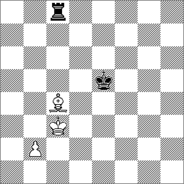Rules of chess
|
|
While the exact origins of chess are unclear, the modern rules of chess first took form in Italy during the 16th century. The rules kept being slightly modified until the early 19th century, when they reached their current form.
| Contents |
Synopsis
Chess is a two-player game that is played on an 8-by-8 board with sixteen pieces of six types, and each type of piece moves in a distinct way. The goal of the game is to protect the most valuable piece, the King, and deliver checkmate to the opponent King.
The board
Chess is played on a square board that is divided into 64 squares (8-by-8) of alternating color (32 white, 32 black), which is very similar to that used in draughts (checkers). Upon the board move 16 "light" and 16 "dark" pieces. Chess set colors are usually black & white, brown & cream, black & red, or green & white.
Sets used for play are commonly made of wood or plastic, although ornamental sets exist made of stone, glass, or metal, which are often used to decorate homes. Likewise, the chessboards themselves can be made of wood, cardboard, leather, stone, glass, or any other material that the design can be placed on. Tables (either of wood or stone) are sometimes made with a chess board designed into the surface. Many travel boards fold into a box that the pieces fit into.
The board is placed so that a light-colored square is in the lower-right corner; a dark one in the lower-left. Each player controls sixteen pieces:
At the beginning of the game, the pieces are arranged as shown in the diagram to the right.
- The second row from the player contain the 8 pawns
- The first row from the player contain the remaining pieces
- Outside corners are the rooks
- Inside of the rooks are the knights
- Inside of the knights are the bishops
- Queen on her own color: white queen on the white square and black queen on the black square
- King takes the vacant spot next to the queen.
To describe moves and locations on the board, either algebraic chess notation or the almost obsolete descriptive chess notation is used.
Gameplay
The game starts with determining colors. This can be done by mutual agreement or by random means such as coin flipping. A common method is for one player to take a pawn of each color, mix them up out of sight, hold one pawn concealed in each hand, let the other player select one of the hands, and play that color. The player controlling the white pieces moves first. While this arguably gives white an advantage, it is generally seen as minor: it is not believed that white can force a win, if black plays properly.
After the initial move by white, play continues by players alternating moves. When a piece is moved it might capture another piece and the captured piece is removed from the board. Play continues until a draw is called or a king is "captured" by means of a checkmate (see below).
Movement
| Chess pieces | |
|---|---|
| | King |
| | Queen |
| | Rook |
| | Bishop |
| | Knight |
| | Pawn |
Each piece moves in a different pattern.
- The rook moves orthogonally to the players (forward, backward, left or right) and any number of squares. Also see castling.
- The bishop moves diagonally and any number of squares.
- The queen moves orthogonally or diagonally and any number of squares.
- The king moves orthogonally or diagonally and only one square at a time. Also see castling.
- The knight moves in an "L"-shape (two spaces in one direction and one space orthogonally to it).
- The pawn can only move away one space (or two spaces, see below) forward in a straight line away from the player, unless there is an enemy piece diagonally (either left or right) one space in front of the pawn; if such a situation occurs, then the pawn may either move diagonally to capture that piece or continue moving in a straight line. The pawn can move one or two spaces if it hasn't moved from its original square. Also see en passant.
Unlike the rest of the pieces, the knight can jump over other pieces when moving. Pieces capture opposing pieces by replacing them on their square, except for the en passant rule.
Two of the most commonly misunderstood moves are castling and en passant. In addition, a pawn reaching the final rank becomes a queen (or, if the player prefers, a rook, bishop or knight) in a process known as "queening" or "promotion".
If a player having the move touches one of his pieces then he is under compulsion to move it provided that it can be moved. If a player touches a hostile piece then he must capture it provided that the piece can be captured. This rule is of no effect if the touched piece cannot be moved or captured.
Castling is treated as a move of the king rather than a move of two pieces; the king must be touched before the rook in order to perform castling. If the rook is touched first, then the rook must be moved if possible. So long as the hand has not left the piece to be moved, the latter can be placed on any accessible square. If a player wishes to touch a piece with the sole intention of adjusting its position on a square, he must first apprise his opponent of his intention by saying "J'adoube" or "I adjust."
If a player has castled illegally, rook and king must be moved back, and the king must make another move, if there is a legal one. If not, any other move can be played. A player who makes an illegal move with a piece must retract that move and make another one, if possible, with the same piece. If the mistake is only noticed later on, the game should be restarted from the position in which the error occurred. However, if blitz chess is being played (where both players have a limited time, e.g. five minutes) and the player who has made a mistake has pressed his/her clock, the other player may call the illegal move and win the game.
Capturing pieces
One important action of chess pieces is to capture other pieces. Except for the pawn, a piece can capture another piece by moving normally to the square the to-be-captured piece is on.
Since the pawn can only move away from the owning player, it has to move to a diagonal square to capture a piece. It cannot move orthogonally to capture a piece – only diagonally.
The player who "captures" the opponent's king (by checkmating it, see below) wins the game.
Check, checkmate
When a player makes a move that threatens the opposing king with capture, the king is said to be in check. If a player's king is in check then the player must make a move that eliminates the threat of capture, which does not necessarily mean the king must be moved. The possible moves to remove the threat of capture are:
- move the king to a square where it is not threatened
- capture the threatening piece
- place a piece between the king and the opponent's threatening piece
A player may never leave his king in check at the end of his move.
In informal games, it is customary to announce "check" when making a move that puts the opponent's king in check. However, in formal competitions this is not only unnecessary but may be considered annoying or distracting.
If a player's king is placed in check and there is no legal move that player can make to escape check, then the king is said to be checkmated, the game ends, and that player loses. The diagram to the right shows a typical checkmate position. The white king is under attack by the black queen; every square to which the king could move is also attacked; and he cannot capture the queen, because he would then be attacked by the rook.
Draws
The game ends in a draw on one of these conditions:
- the player to move is not in check but has no legal move (this is called a stalemate, and such a position is shown in the diagram to the right.)
- there is no possibility for either player to checkmate the opponent
- By agreement of the players
Either player may claim a draw by indicating that one of the following conditions exists:
- fifty moves have been played by each player without a piece being captured or a pawn moved
- the same board position has been repeated three times, with the same player to move and all pieces having the same rights to move, including such things as the right to castle or capture en passant. In particular, if a player is able to check the opposing king continually (perpetual check) and he indicates his intention to do so, the game is considered a draw.
Timing
Tournament games are played under time constraints. Each player must make all his moves in a specified time, or be in danger of forfeit.
- If there is a checkmate on the board, the player delivering checkmate wins, no matter what is subsequently noticed about the time.
- If player A calls attention to the fact that player B is out of time, but it is then noted that player A is also out of time, the game is drawn.
- If player A calls attention to the fact that player B is out of time, player A is not out of time, and player A has sufficient material to checkmate (either a pawn, a knight and a bishop, two bishops, a rook, or a queen), then player A wins immediately.
- If player A calls attention to the fact that player B is out of time, and player A does not have sufficient material to checkmate, the game is drawn.
Various tournament rules have been devised to prevent players from playing on with no practical chances of winning on the board, intending merely to win when their opponent runs out of time. For example, a king and rook versus a king, bishop, and pawn cannot be won by either player 99% of the time, even though both sides theoretically have enough material to checkmate. The player with more time might play quickly in hopes of inducing a blunder or running out the opponent's clock. If a player believes his opponent is attempting to win a drawn position on time, he may appeal to a tournament official, who may impose a result or a penalty in accordance with whatever rules are in effect for that tournament.
In formal competition, each player is obliged to record each move as it is played in order to settle disputes about illegal positions and overstepping time control. Algebraic chess notation is presently used for this, though some players still use descriptive chess notation.
See also
External links
- Official FIDE rules (http://www.fide.com/official/handbook.asp?level=EE101)ca:Reglament_dels_escacseo:Bazaj reguloj de ŝakofr:Rčgle du jeu d'échecs pl:Zasady gry w szachy sl:šahovska pravila pt:Regras do xadrez

